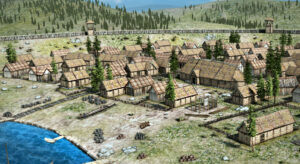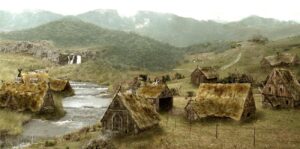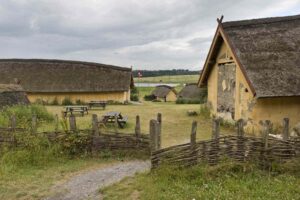Nestled within the pages of history, the Norse settlements stand as enigmatic testaments to the Viking era’s rich tapestry. These seafaring people, known for their prowess in exploration and warfare, left an indelible mark on the lands they touched. As we embark on this historical journey, the air is thick with the scent of saltwater and the echoes of ancient sagas. The allure of the Viking Age lies not only in its tales of conquest but also in the mystery shrouding their daily lives and communities.
The Norse Way of Life

In the heart of these settlements, a unique way of life unfolded. Vikings were not merely warriors; they were skilled farmers, traders, and craftsmen. The homesteads were the epicenter of their existence, with longhouses dominating the landscape. These structures, often exceeding 100 feet in length, were communal dwellings housing multiple families. The daily life of a Norseman revolved around the longhouse, where meals were shared, stories were told, and decisions were made.
Within the settlements, a complex social hierarchy thrived. Chiefs and jarls, leaders of considerable influence, guided their communities. However, the egalitarian spirit of the Vikings was evident in their Thing assemblies, where free men could voice their opinions and participate in decision-making. This intricate balance of power and camaraderie made the Norse way of life distinct and captivating.
Unraveling the Norse Pantheon
No exploration of Viking settlements is complete without delving into their religious beliefs. The Norse pantheon, a collection of gods and goddesses, cast a spiritual aura over daily life. Odin, the All-Father, presided over Asgard, while Thor, the god of thunder, wielded his mighty hammer Mjölnir. The Vikings’ connection with the divine extended beyond grand temples; household rituals and personal offerings were commonplace.
The interweaving of mythology and reality was evident in the design of Norse settlements. Sacred spaces were dedicated to religious ceremonies, and runic symbols adorned various structures, invoking the protection of the gods. The Norse people lived in harmony with the natural world, attributing spiritual significance to the elements. Exploring the remnants of these settlements allows us to connect with a worldview where the earthly and the divine coexist.
Navigating the Viking Waterways
The Vikings’ reputation as seafarers is etched in the annals of history, and their settlements strategically positioned along waterways tell tales of maritime mastery. Rivers and fjords acted as highways, connecting disparate Norse communities. The longships, iconic vessels with their dragon-headed prows, carried the Vikings across vast distances, enabling exploration, trade, and, at times, raids.
The importance of maritime trade in Norse society cannot be overstated. The Vikings engaged in commerce with distant lands, exchanging goods and ideas. The bustling harbors and trading posts were hubs of cultural exchange, fostering a melting pot of influences within the Norse settlements. Through the lens of their navigational prowess, we witness the Vikings not merely as raiders but as global citizens of their time. This exposure to the sea also served easier canal systems, but agriculture was still limited. As everything is more advanced today, we still have to pay attention to the water supply in our home and the fact that the pipes can burst due to the accumulation of limescale, and then we can call the emergency restoration services in Charlotte.
The Norse Sagas: Chronicles of Heroism and Tragedy
Embedded within the Norse settlements are the sagas, epic narratives that transcend time. These tales of heroism and tragedy offer a glimpse into the complex tapestry of Viking society. Passed down through generations, the sagas are both historical records and poetic expressions of the Norse worldview. As we immerse ourselves in these sagas, we discover the nuanced characters, the gripping conflicts, and the enduring themes that shaped the Viking narrative. Science tutors in Boulder explain to their students in depth the history of these peoples, telling them some of these stories along the way.
Exploring the sagas takes us beyond the material remnants of the settlements. These literary masterpieces provide insights into the moral code of the Vikings, their concepts of honor, and the intricate web of familial ties. The sagas are not mere chronicles; they are living echoes of a bygone era, inviting us to navigate the emotional landscapes of heroism, love, and tragedy that defined the Norse experience.
Innovations in Norse Craftsmanship
The Norse settlements were not only centers of human interaction but also crucibles of craftsmanship. Vikings were skilled artisans, employing innovative techniques that produced artifacts of both practical and aesthetic value. Beyond the utilitarian longhouses, intricate wood carvings adorned everyday items, showcasing a dedication to detail and a sense of artistic expression. Special wine glasses in the form of goblets were very important objects showing the status of an individual.
One notable example is the masterful metalwork of the Norse people. The forging of weapons, tools, and ornamental objects reached unprecedented heights. The Ulfberht swords, renowned for their superior quality, reflected a level of metallurgical expertise that surpassed contemporary standards. These artifacts not only served practical purposes but also carried symbolic significance, embodying the martial prowess and artistic sensibilities of the Viking culture.
The Intricacies of Norse Navigation

While the prowess of Norse seafaring is well-documented, the intricacies of their navigation techniques add another layer to the narrative. Long before the advent of modern technology, Vikings relied on a deep understanding of celestial bodies, ocean currents, and natural landmarks. The sun compass, a simple yet effective navigational tool, guided them through the vast expanses of open water. Today, of course, there is no need for that, a roadside assistance app is enough to keep us safe while traveling.
The sagas speak of legendary navigators who could read the nuances of the sea and the skies with unparalleled precision. These seafarers ventured into uncharted waters, exploring far-off lands and establishing trade routes that stretched across continents. As we unravel the mysteries of Norse navigation, we gain a profound appreciation for the courage and ingenuity that fueled their maritime exploits.
Culinary Traditions of the Norse
Beyond the battles and seafaring adventures, the Norse settlements were hubs of culinary innovation. The harsh climates of Scandinavia did not deter the Vikings from cultivating a rich culinary heritage. The bounty of the land and sea found its way into the longhouse kitchens, where communal feasts became a celebration of both sustenance and cultural identity. Today you can try to prepare some of their traditional dishes using new kitchen appliances that will help you, but if one of them does not work, take it to an appliance repair service in Washington DC.
Fish, game, and foraged vegetables formed the basis of Norse cuisine. The preservation methods employed, such as smoking and drying, ensured a steady food supply during the long, harsh winters. The communal feasting culture, symbolized by the mead hall gatherings, fostered a sense of unity and shared identity. Exploring the culinary traditions of the Norse settlements allows us to savor not only the flavors of the past but also the communal spirit that infused daily life.
Viking Aesthetics: Art and Adornments
The Vikings were not only warriors and seafarers but also individuals with a keen aesthetic sensibility. The adornments and artistic expressions found within the settlements reveal a commitment to beauty and symbolism. Intricate brooches, finely crafted jewelry, and textile embellishments adorned both men and women, reflecting not only social status but also personal expression. Horsemen had specially sewn saddle blankets to show their status.
The use of color and patterns in Norse clothing was not arbitrary; it conveyed cultural symbols and affiliations. The sagas describe the significance of specific colors, such as deep reds and blues, in denoting social standing or allegiance to a particular deity. The attention to detail in personal adornments extended to the decoration of everyday items, turning mundane objects into works of art that spoke to the craftsmanship and aesthetic consciousness of the Vikings. Embracing a fusion of ancient charm and urban chic, a Viking in Toronto might find himself trading his traditional garb for a stylish contemporary makeover at a beauty salon in Toronto, seamlessly blending the rugged spirit of the Norse with the city’s modern aesthetic offerings.
The Decline and Legacy of Norse Settlements
As we approach the twilight of the Viking Age, the decline of Norse settlements becomes a poignant chapter in their history. External pressures, changing economic dynamics, and internal conflicts contributed to the gradual abandonment of some settlements. The once-thriving communities faded into the annals of time, leaving behind echoes of their vibrant past. An internet service provider that manages IT services in San Antonio provides its users with excellent internet with which they can watch a number of excellent series and documentaries about this period for the Vikings.
Yet, the legacy of the Norse settlements endures. The linguistic and cultural impact of the Vikings persists in the Scandinavian countries, where echoes of Old Norse can still be heard. The artifacts and remnants of the settlements, now preserved in museums, stand as tangible links to a bygone era. The sagas, transcending the passage of centuries, continue to captivate readers and scholars alike, ensuring that the spirit of the Norse people lives on in the collective consciousness of humanity.
Did you know that many tourist agencies that provide a tour to the Viking villages use services from the best website hosting in Green Bay to host their websites?
Rediscovering the Norse Settlements Today
In the contemporary world, the exploration of Norse settlements takes on new dimensions. Archaeological advancements and interdisciplinary studies allow us to unravel more secrets buried beneath the soil. The integration of technology, from 3D modeling to satellite imagery, provides a holistic understanding of the layout and structures within these ancient communities. Through Google ads, the general public can be directed to important historical discoveries that significantly change the opinions we have had so far, but if your Google ads are suspended, contact a professional.
Archaeological tourism has also emerged as a means of bridging the temporal gap between the modern observer and the Vikings. Walking through the remnants of a longhouse or standing by a rune-inscribed stone transports us to an era of sagas and seafaring. Museums dedicated to Viking history showcase artifacts with meticulous detail, offering a tangible connection to the material culture of the Norse people. In addition, enthusiasts can enhance their experience by donning comfortable and stylish veteran hoodies while exploring these captivating historical sites, adding a touch of contemporary flair to their journey through ancient times.
The Ongoing Dialogue with Viking Heritage

As we continue to delve into the enigmatic Norse settlements, the dialogue with Viking heritage remains an ongoing journey. Scholars, historians, and enthusiasts contribute to a dynamic discourse that seeks to contextualize the past within the framework of the present. The Norse settlements, once silent witnesses to a bygone era, now echo with the voices of those who seek to understand, interpret, and celebrate the legacy of the Vikings. In order to celebrate the heritage of these people yourself, you can book cheap flights to these countries whenever you want.
The exploration of Norse settlements goes beyond the realms of academia; it resonates with a broader audience eager to connect with the roots of European history. Festivals, reenactments, and cultural events celebrate the vibrant aspects of Viking heritage, inviting people of all ages to immerse themselves in the spirit of the Norse world. This living engagement ensures that the legacy of the Norse settlements remains not only a historical curiosity but a vibrant and evolving part of our cultural tapestry. Special online courses serve to unite the enthusiasts of this world into one community that is engaged in greater research and spreading the story of these people.
Conclusion
The Norse settlements stand as windows into a world both familiar and foreign. They invite us to explore the intricacies of daily life, the sagas that define heroism, the craftsmanship that shaped their material culture, and the intrepid navigation that connected distant shores. As we navigate the enigmatic realms of Viking history, we discover not just a chapter in the past but a living, breathing legacy that continues to captivate and inspire. The Norse settlements are not mere archaeological sites; they are portals to a time when the spirit of exploration, creativity, and resilience defined the ethos of a people who left an indelible mark on the course of history. When you want to go through these excavations of the ancient peoples, consider getting diagnostics done at the transmission service in Buffalo beforehand so that you are safe during the trip.